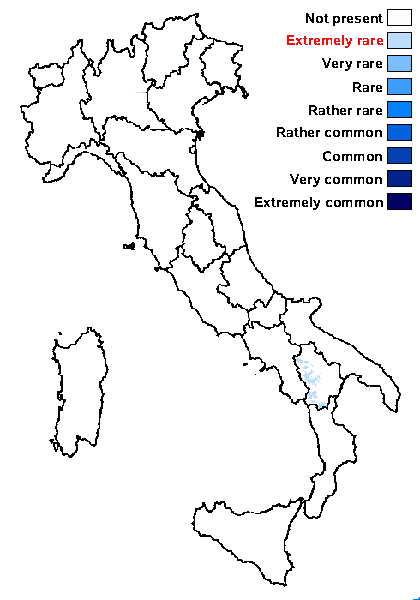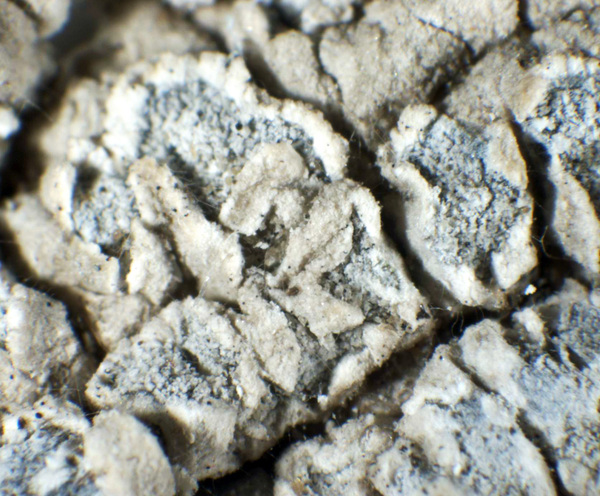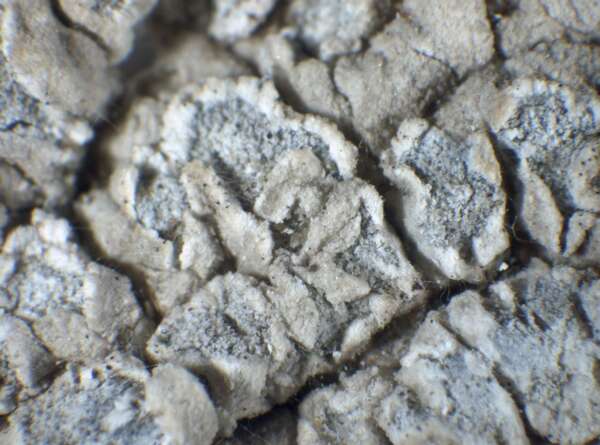Pertusaria paramerae A. Crespo & Vězda
Anal. Jard. Bot. Madrid, 41, 2: 252, 1985.
Synonyms:
Distribution: S - Bas.
Description: Thallus crustose, thinly episubstratic, white-grey or with a yellow-brown tinge, continuous to rimose-areolate. Apothecia numerous, crateriform, not constricted at base, immersed into 0.5-1.5 mm wide fertile warts, with an initially punctiform, later irregularly open, black disc covered with a thick, white pruina, and a prominent thalline margin. Epithecium yellowish green, K+ and N+ pink violet; hymenium and hypothecium colourless. Asci 2-spored, broadly cylindrical, the apex with a broad ocular chamber, the outer sheath K/I+ blue, otherwise K/I-, with an inner extensible layer, Pertusaria-type. Ascospores 1-celled, hyaline, ellipsoid, 120-190 x (40-)60-75(-90) µm, double-walled, the wall 5-8 µm thick, transversally striate. Photobiont chlorococcoid. Spot tests; thallus K+ pale yellow, C-, KC+ yellow orange P-. Chemistry: planaic acid (major), thiophaninic acid (trace), atranorin (trace), chloronorlichexanthone (trace), and an unidentified substance (trace,). Note: a species described from the Iberian Peninsula, where it mostly grows on Juniperus thurifera, and reported from Turkey; the only Italian station is in Basilicata.Note: this species was described from the Iberian Peninsula, where it mostly grows on Juniperus thurifera. According to Sipman (in litt.), who has studied the specimen, the earlier record of P. rhodiensis from Basilicata (see Nimis 1993: 519) refers to P. paramerae. The species, which is also known from Turkey, is chemically variable (see Halici & al. 2010).
Growth form: Crustose
Substrata: bark
Photobiont: green algae other than Trentepohlia
Reproductive strategy: mainly sexual
Commonnes-rarity: (info)
Alpine belt: absent
Subalpine belt: absent
Oromediterranean belt: absent
Montane belt: extremely rare
Submediterranean belt: absent
Padanian area: absent
Humid submediterranean belt: absent
Humid mediterranean belt: absent
Dry mediterranean belt: absent

Predictive model
Growth form: Crustose
Substrata: bark
Photobiont: green algae other than Trentepohlia
Reproductive strategy: mainly sexual
Commonnes-rarity: (info)
Alpine belt: absent
Subalpine belt: absent
Oromediterranean belt: absent
Montane belt: extremely rare
Submediterranean belt: absent
Padanian area: absent
Humid submediterranean belt: absent
Humid mediterranean belt: absent
Dry mediterranean belt: absent

Predictive model
 Index Fungorum
Index Fungorum
 GBIF
GBIF




